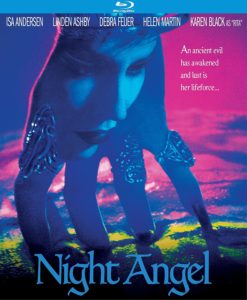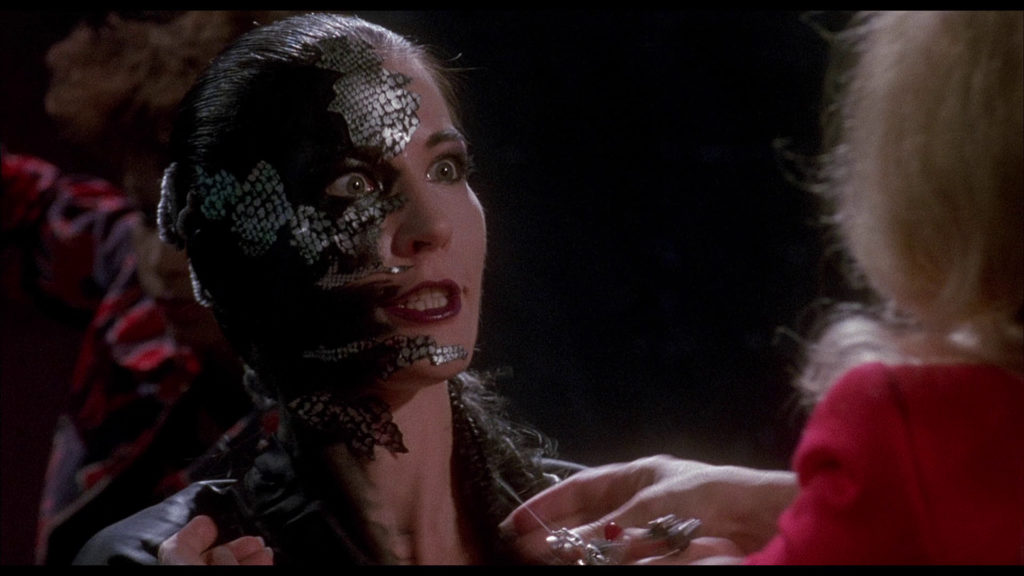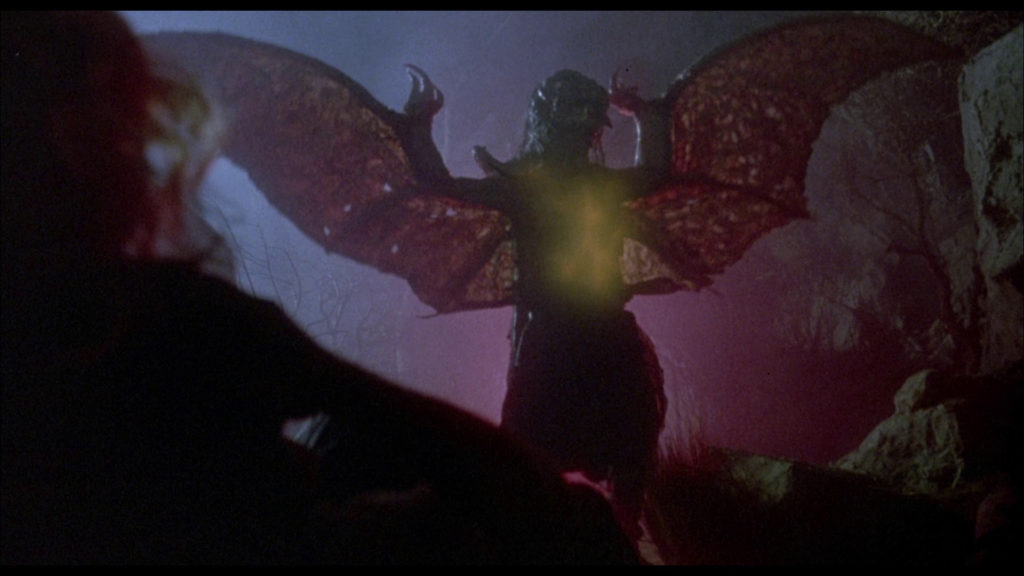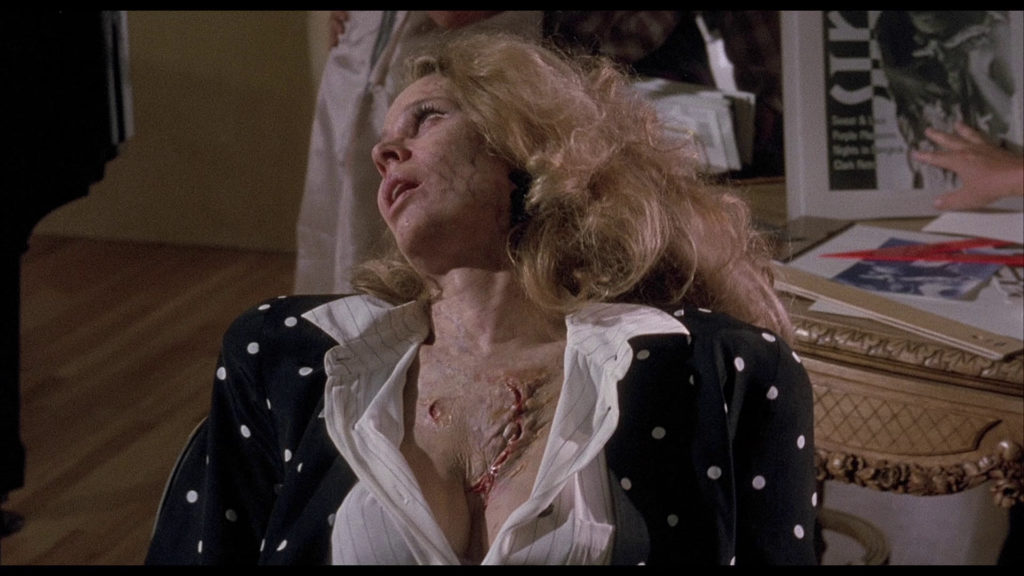The Deadliest Lilith Fair yet.
DIRECTED BY DOMINIQUE OTHENIN-GIRARD/1990
STREET DATE: OCTOBER 24, 2017/KINO LORBER STUDIO CLASSICS
 When it comes to the vengeance of an outcast first wife, alimony can be a bloody horror show.
When it comes to the vengeance of an outcast first wife, alimony can be a bloody horror show.
Factor in supernatural powers and a raging, opportunistic lust so perversely potent that it could only stem from the Old Testament or the hotel room of Harvey Weinstein, and you’ve got Lilith, the forgotten demon wife of Adam, prior to Eve. Sometimes known as “the whore of Satan”, Lilith is actually the stuff of Jewish myth. (The character is only vaguely mentioned once, if that, in the Christian Bible, kinda sorta in Isaiah 34). Lilith has been told of numerous permutations, having gone by many other names, including “night creature”, “night hag”, “night monster”, and “screech owl”. “Night angel”, though, isn’t listed among them. (Per Wikipedia, at any rate).
This movie’s title can’t be the only inaccuracy in this film’s realization of Lilith, though honestly, it scarcely matters. A strange and fascinating film, Night Angel, in all its flaws and clunkiness, lies as a lingering fragment of certain 1980s tropes, sensibilities (and lack thereof), and attitudes. That’s not to mention the moment’s music, practical visual effects (including some early hands-on work by NKB) and hair styles. This movie is so gloriously, badly 1989, all that’s missing is a Batman t-shirt. (Technically, Night Angel dropped in 1990, but those of us who were there know that 1990 was basically a gaudy extension of 1989. Which itself, movie-wise, was a diluted version of 1984.)
A strange and fascinating film, Night Angel, in all its flaws and clunkiness, lies as a lingering fragment of certain 1980s tropes, sensibilities (and lack thereof), and attitudes.
That’s not to mention the completely gawdawful cover image, carried over by Kino Lorber from the film’s old VHS box. It must be the most ugly, overthought collage of everything considered quote-unquote “erotic” or, “sensual” or, “erotically sensually dangerous” at the time: A touching hand! (Because, our supernatural murderess murders people with her fingahnailz!) the face of the fatale (actress/model Isa Jank, working hard to validate herself in the former profession), the city at night, pink and purple gel-filter coloring run amok – all right there, in an unintelligible barrage that offers nothing but the promise of dated VHS-era would-be sultry horror. This movie, while striving back in the day to be those things, actually ends up being something more – if only by the thinnest of margins.

Lilith, ever the serpent.
For all the popular paganism surrounding the premise of the return of para-Biblical villainess Lilith, Night Angel winds up in a surprisingly traditionally Christian place, in terms of spiritual good versus evil. Helen Martin (from the TV series 227) is always on the periphery, stalking Lilith and eventually turning up to provide exposition on the enemy, exactly why she needs to be killed, and even why she wants to kill her. She’s brought her special dagger for just the occasion. Hers is a righteous anger, as she’s also a much-needed Van Helsing-esque figure amid the parade of disposable white male stooges.
It’s easy to assume that anyone involved in the effort to get this movie green-lit was not thinking about crafting a spiritual commentary that validly comments on gender roles and objectification in mass media even several decades from then. This is post-“video nasty” trash, right…? According to the screenwriter and director, both on hand for their current day thoughts, there were indeed loftier ideas in the initial creative intentions. Loftier ideas that involve a scantily clad beautiful nightmare lady, sure. But nonetheless, out-of-the-gate deeper notions were bandied at that phase. But, a three-week shoot with a shoestring budget has a way of diluting just about any intentions other than “just get the thing filmed!!”
The result is Night Angel, a lost-to-the-ages late night grasp at sending up the passion-as-fashion cocaine couture culture evident in everything from Wall Street to GLOW. Deadly Lilith did not go on to rapidly churned-out sequels, vying for the still-vacant token female seat at the super-slasher table, alongside of Freddy Krueger, Michael Myers and Jason Voorhees. But, it could’ve been such…

Practical!
What did happen was that director Dominique Othenin-Girard’s career made a pronounced veering from pre-Night Angel slashers, like Halloween 5, into Red Shoe Diaries territory, and stayed there as long as the checks kept clearing. The only star to advance from Night Angel is the guy who gives the most out of place performance, fan favorite and spindly Christian/humanitarian actor, Doug Jones. With his work with filmmaker Guillermo Del Toro and on Star Trek: Discovery, it’s quite safe to say that Jones has come a wonderfully long way, and has since landed on his feet. In this movie, he’s just playing a ridiculous horny spazz. But unlike all of his more celebrated work, in this film we see his actual face!
Those looking for reconciliation between Night Angel’s traditionally moral denouement and it’s persistently exploitative elements will likely toil in vain, perhaps aside from the idea that the myth of Lilith itself is exploitation. Meaning, it exploits of a perceived loophole in Genesis where God apparently created a female prior to Eve. This notion is something that’s been fascinatingly construed and remolded from one agenda to another since it came to prominence circa 700 AD, sometimes radically opposed. Touted as both the first warrior for female equality as well as an aggressive perversion of that ideal and/or the ultimate sexual pariah, Lilith has seduced select imaginations as the original femme fatale. In that sense, it’s a shame that such a potentially deep well of culturally rooted sexual and gender unease hasn’t been more property explored. Night Angel itself, as sex-positive as it is sex-negative, refuses a true stance on whether female power, energy and passion is a threat or not. This is to its own detriment; not that conventional resolution is required, but insomuch as the film’s own resolutions are so nakedly lazy and sloppy.

Karen Black in NIGHT ANGEL.
Considering the latent obscurity of this title, it’s surprising if also commendable how many bonus features that Kino Lorber Studio Classics has seen fit to include. There are two, count ‘em, two feature length audio commentaries, one with the director (still proud of this movie) and the other with film historian Jason Pichonsky. Additionally, we get new video interviews with star Isa Jank, obviously disillusioned screenwriter Joe Augustyn, and Special Makeup Effects Designer & Creator Steve Johnson. Then, there are gobs of vintage video clips of Johnson’s tests of various practical gore effects for use the movie. Finally, there’s the trailer and still images gallery.
Also starring a young Debra Feuer, Linden Ashby and Karen Black (a bit of an odd screen matriarch by then), it’s fair to say Night Angel never quite ascends to the heavens. But for those intrigued with the Lilith myth in the context of some straight-ahead low-budget horror filmmaking, this is the one to be taken in by.

